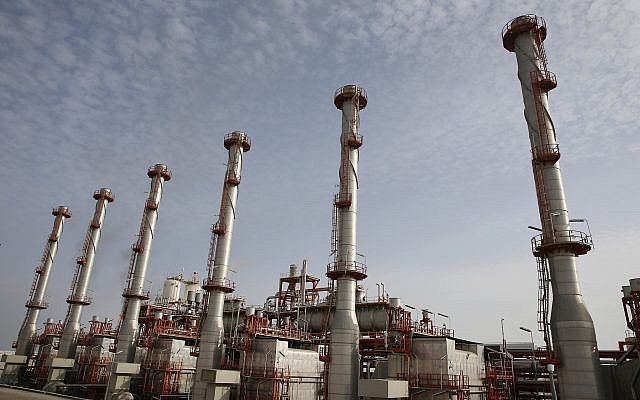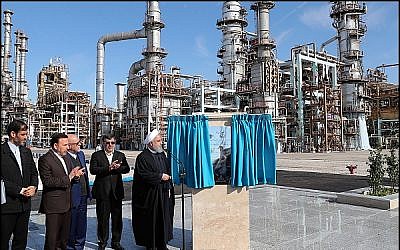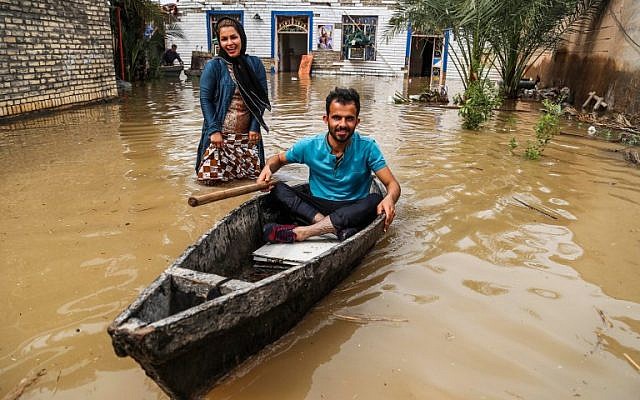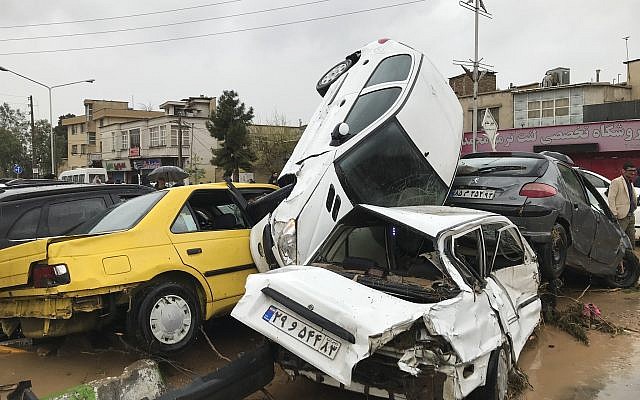Official says Washington wants ‘continued chilling effect,’ Tehran accuses US of hampering rescue efforts as fresh floods drown cities in western Iran

A US official said Washington was considering bolstering sanctions against Iran Monday, as Tehran protested that existing financial constraints placed by the US were hampering recovery efforts as the country continued to be hammered by deadly floods.
The official, speaking on the condition of anonymity, said the new sanctions could come in May, a year after US President Donald Trump pulled out of the 2015 nuclear deal, putting many of the lifted penalties back in place.
“We just want a continued chilling effect,” the official said, according to Reuters. “We want businesses to continue to think doing business with Iran is a terrible idea at this point.”
The official said the new sanctions could target oil imports, specifically rescinding waivers handed to eight countries allowing them to continue buying oil from Iran.
“That, I think, is where we’re headed,” the official said.
Under the 2015 deal, Iran pledged not to resume atomic weapons work and the UN’s atomic watchdog says Iran continues to comply with the agreement. The US, however, pulled out of the agreement last year, saying it was fatally flawed and allowed Iran to gradually begin advanced atomic work over time. Prime Minister Benjamin Netanyahu cheered the decision and has urged other parties to follow suit.

The Trump administration has continued to impose new sanctions as part a pressure campaign to force Iran to renegotiate the agreement. Trump in the past has vowed to kill the Iranian oil industry, one of the country’s only main economic lifelines.
On Monday, Iranian Foreign Minister Javad Zarif accused the United States of impeding aid efforts and of “economic terrorism,” as the country was hit by fresh floods.
US sanctions are “impeding aid efforts by #IranianRedcrescent to all communities devastated by unprecedented floods,” Zarif tweeted, referring to search and rescue operations being conducted after huge rainfalls triggered vast flooding.
“Blocked equipment includes relief choppers,” the tweet read, adding that “this isn’t just economic warfare; it’s economic TERRORISM.”
Authorities on Monday as authorities ordered the immediate evacuation of flood-stricken cities in western Iran after rivers burst their banks, dams overflowed and vast areas were cut off from communication.

A chronic shortage of rescue helicopters in Iran, due to US sanctions, has forced the emergency services to request help from military helicopters and amphibious armored personnel carriers to assist in the rescue operations.
The authorities declared a “situation red”, the highest level of alert, in Lorestan province with four or five cities “completely critical,” state television news network IRINN reported from Khorramabad, the region’s capital.
“In Khorramabad the water has risen by as much as three meters (nearly 10 feet) in parts… and reports are coming in of regions… completely submerged with residents stranded on their rooftops,” it added.
The Red Crescent’s provincial director, Sarem Rezaee, said his organization had lost contact with much of the region.
“Telephones are not working, our radio communications are down… at this moment we have no news of other cities and villages,” he told IRINN, adding roads were flooded and helicopters were unable to take off due to the bad weather.
“We have requested emergency help from neighboring provinces but at the present no one can do anything.”
The airport in the western city of Khorramabad was flooded, with images showing water submerging the runway and cutting the province’s main air link to the rest of the country.
Authorities in Lorestan ordered evacuations in many regions, bringing in the armed forces to forcibly remove those who do not comply, local media reported.
Numerous rivers had burst their banks and landslides blocked many roads, according to reports.

Media outlets showed images of collapsed bridges and oil and gas pipelines destroyed by the flood.
The main railway line linking Tehran to the south of the country had also been blocked by the flood.
This is the third major flood to hit Iran in the past two weeks with unprecedented rainfalls in the mostly arid country that had endured a decades-long drought until this year. Heavy rains are expected to continue into Tuesday.
The first occurred in the northeast of the country on March 19 and the second struck the west and southwest of Iran on March 25 with a combined toll of 45 people killed.
As reported by The Times of Israel
